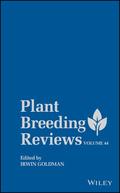Plant Breeding Reviews, Volume 44
Plant Breeding Reviews (Band Nr. 44)

1. Auflage Februar 2021
336 Seiten, Hardcover
Wiley & Sons Ltd
Plant Breeding Reviews presents state-of-the-art reviews on plant genetics and the breeding of all types of crops by both traditional means and molecular methods. Many of the crops widely grown today stem from a very narrow genetic base; understanding and preserving crop genetic resources is vital to the security of food systems worldwide. The emphasis of the series is on methodology, a fundamental understanding of crop genetics, and applications to major crops.
1 Salvatore Ceccarelli: Plant Breeder, Mentor, and Farmers' Friend 1
Stefania Grando
I. Biographical Sketch and Background 2
II. Research 6
III. The Man 17
IV. The Mentor and Inspirer 19
V. The Innovator 20
VI. The Supporter of National Programs 21
VII. The Advocate of Farmers 21
Acknowledgments 22
Literature Cited 22
Selected Publications of Salvatore Ceccarelli 25
2 Maize Cross Incompatibility and the Promiscuous Ga1-m Allele 31
Major M. Goodman, Zachary G. Jones, G. Jesus Sanchez, and Jerry L. Kermicle
I. Historical Background 33
II. Ga1 (Gametophyte-Factor 1), Ga2 (Gametophyte-Factor 2), and Tcb1 (Teosinte-Crossing-Barrier 1) 34
III. Ga1-m (Gametophyte-Factor 1-Male) 35
IV. Locus Composition 35
V. Gametophytic Selective Advantage 36
VI. Silk Reactions 36
VII. Mapping Gametophytic Loci 38
VIII. Geographical Distribution of Ga1 Alleles 38
IX. Distribution of Ga1 Alleles in Commercial Materials 41
X. Teosinte and Maize 41
XI. Popcorn and Organic Isolations 43
XII. Exceptionally Strong Cross-Incompatible Sources Within Maize 44
XIII. Caution Concerning Use of Ga1-m 45
XIV. Genetic Modifiers 46
XV. Molecular Characterizations 47
XVI. Recent Conclusions 47
XVII. Practical Use of Pollen-Blockers 47
XVIII. Future Prospects 50
Acknowledgments 54
Literature Cited 54
3 Development of the Genetically Modified Innate(r) Potato 57
Craig M. Richael
I. Introduction 58
II. Innate(r) Generation 1 Potato Varieties 65
III. Innate(r) Generation 2 Potato Varieties 71
IV. Future Innate(r) Potato Varieties 74
V. Conclusions 75
Literature Cited 76
4 Cucumis sativus Chromosome Evolution, Domestication, and Genetic Diversity: Implications for Cucumber Breeding 79
Yiqun Weng
I. Introduction 81
II. Chromosome Evolution in the Making of Cucumber 83
III. Chromosome Evolution During Cucumber Domestication 86
IV. Diffusion of Cucumber to the World From its Center of Diversity and the Formation of Market Groups 90
V. Types of Cucumbers: Fresh Market vs Processing 92
VI. Genetic Diversity and Population Structure of Cucumber Collection 94
VII. Genetic Basis of Domestication-Related Traits in Cucumbers 96
VIII. Chromosome Evolution, Domestication, and Genetic Diversity: Implications for Cucumber Breeding 101
Acknowledgments 104
Literature Cited 104
5 Freelance Plant Breeding 113
Carol S. Deppe
I. Introduction 115
II. Evolution of a Freelance Plant Breeder 116
III. Who and Where 119
IV. How Freelancers Learn the Plant Breeding Trade 130
V. Why--Motivations and Values 136
VI. Crops 139
VII. Goals 146
VIII. Methods 151
IX. Sources of Germplasm 161
X. Economics of Freelance Plant Breeding 164
XI. Freelance Plant Breeding That Doesn't Fit Commercial Models 174
XII. Open Source Seed Initiative and Freelance Plant Breeding 176
XIII. Future Prospects 180
Acknowledgments 183
Literature Cited 183
6 Meadowfoam Breeding 187
Jennifer G. Kling
I. Introduction 189
II. Botany and Taxonomy of Limnanthes 190
III. Meadowfoam Breeding Organizations 195
IV. Seed Production Requirements 197
V. Greenhouse and Field Plot Techniques 201
VI. Selection Methods 206
VII. Breeding Populations and Molecular Resources 216
VIII. Meadowfoam Seed Oil 222
IX. Biotic Constraints 225
X. Glucosinolates and Other Seed Meal Components 230
XI. Meadowfoam in Cropping Systems 234
XII. Conclusions and Future Directions 235
Acknowledgments 237
Literature Cited 237
7 Reconsidering Approaches to Selection in Winter Squash Improvement: Improved Quality and Breeding Efficiency 247
Michael Mazourek, Christopher Hernandez, and Jack Fabrizio
I. Introduction 249
II. Genomic Resources for Winter Squash Improvement 251
III. Insight into Winter Squash Metabolism Related to Fruit Quality 253
IV. Winter Squash Quality Phenotyping 258
V. Squash Breeding Schemes 260
VI. Applying Genomic Selection in Cucurbita 264
VII. Conclusion 268
Acknowledgments 268
Literature Cited 269
8 Development of the Arctic(r) Apple 273
Evan Stowe and Amit Dhingra
I. Introduction 274
II. Genetic Engineering of Apple 275
III. Development and Evaluation of the Arctic(r) Apple 280
Literature Cited 292
Author Index 297
Subject Index 305


